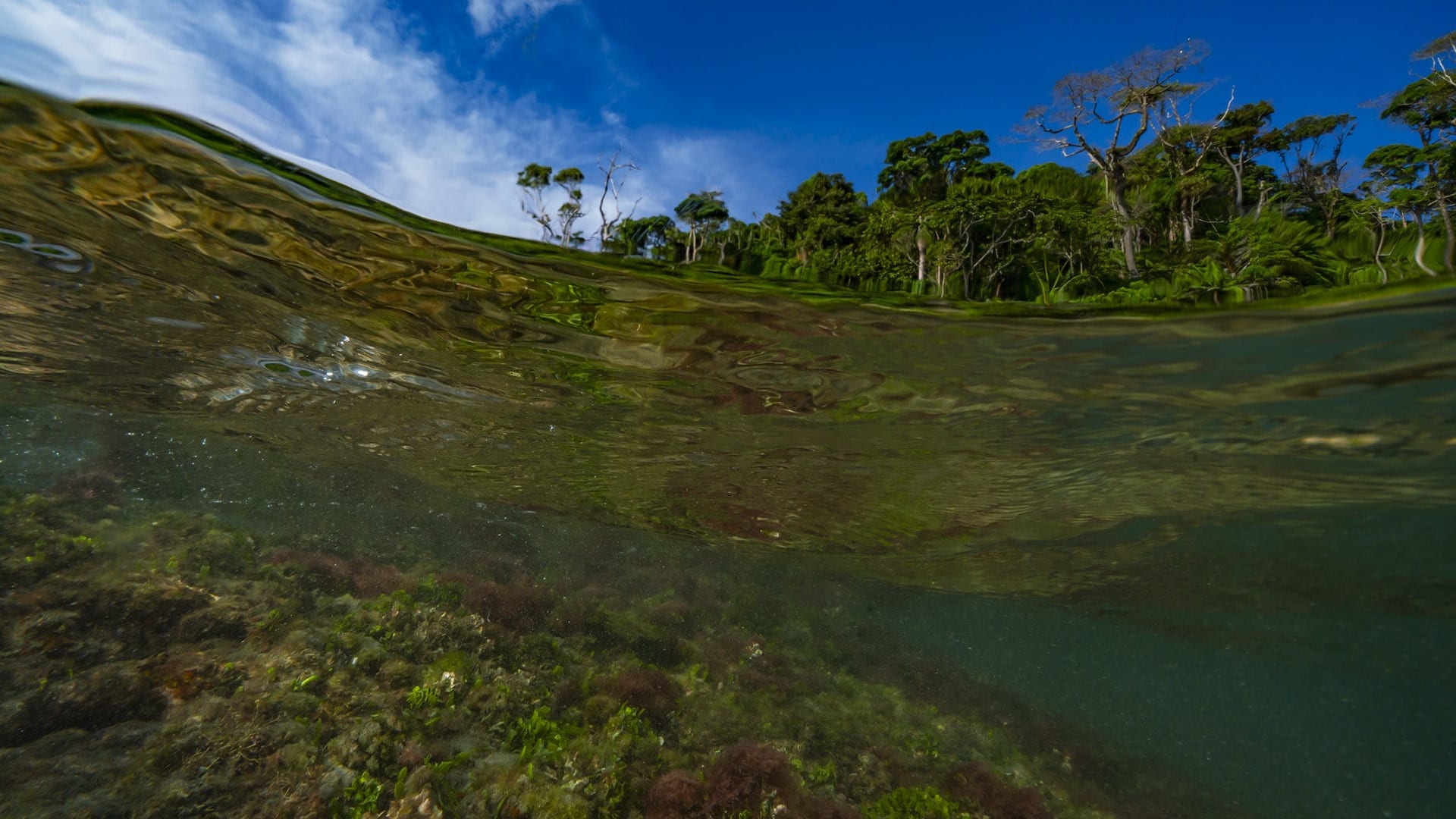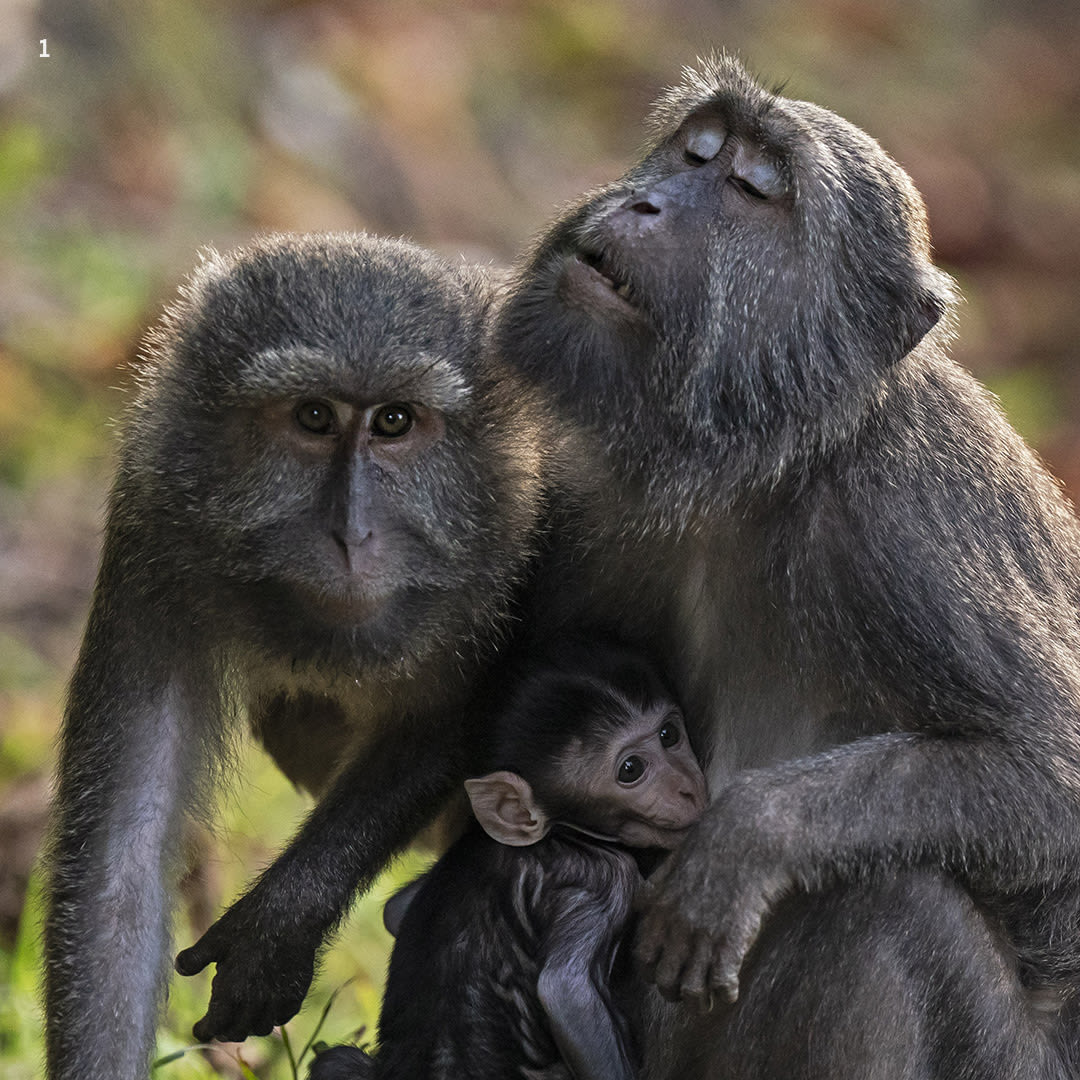 Listen to this article
•
15:34 min
Listen to this article
•
15:34 min
The Andaman and Nicobar Islands (ANI) are tiny blips of land caught between the Bay of Bengal and the Andaman Sea — forming a linear mass of socio-ecological diversity. While it’s easy to gloss over these islands on a map, zooming in reveals how their unique geographical positioning has resulted in an alluring array of plants, animals, and habitats, distributed across that long strip off the eastern coast of India.
The southernmost of these islands is Great Nicobar Island, the largest of the Nicobar group of islands at 910 sq km. I was fortunate to work there and study its resident primates, triggering an unending fascination for the place. Far removed from the mainland, getting there involves a two-day ship ride from Port Blair, across expanses of shimmering sea. From aboard the ship, armed with my binoculars and the solitude of zero cellular connectivity out at sea, I’d watch somersaulting spinner dolphins, travelling bottlenose dolphins, the swift outlines of tuna and emperor fishes, and the constant relay of flying fish darting away from the ship’s hull.
Cover photo: Great Nicobar Island is the last of the 500-odd islands that form the Andaman and Nicobar archipelago. The island is home to several endemic species that are found only along these islands and nowhere else in the world. Photo: Dhritiman Mukherjee
Great Nicobar’s habitats
As the ship halted, I saw waves crashing over a sliver of sandy beach. Just beyond the coast, drooping mangroves formed a thin wall with interlocked leaves and roots, concealing the island’s contents. Peeking above these were dense rainforest trees, giving the island a bumpy green silhouette.
While I was there to study the endemic Nicobar long-tailed macaques, large-bodied pied imperial pigeons greeted me at the jetty. Found only on a few of the ANI, these large birds that perch in sizeable flocks on tall trees or sit hidden atop palm leaves soon became the most common sight outside my tsunami shelter — a little window into the island’s biodiversity.
The island is home to about 8,500 people, mostly living along a 35-kilometre belt along the southeastern coast. Outside this area, over 80 per cent of the island has tree cover. Expanses of tropical rainforests sprawl over the island and house a majority of its faunal diversity. There are also marshy stretches of littoral (coastal) forests along the coast. These comprise several mangroves (like Rhizophora and Bruguiera species) and the endemic screwpine (Pandanus fascicularis), which are steadily regenerating after they were ravaged by the tsunami of 2004. The island also has a hard-edge habitat, where forested land meets agricultural and semi-urban spaces that people across mainland India have called home since the 1960s. This diversity of habitats makes for micro-environments within which rare (and several endemic to Great Nicobar) species of plants, animals, insects, crustaceans, and marine life are found.

Diversity and little-known biodiversity
The Nicobar megapode (Megapodius nicobariensis), a species of scrubfowl endemic to a few Nicobar Islands, is a tall, brown, dusty bird with a red pinball head. While these birds may seem unimpressive at first glance, they are master architects that use leaf litter, loose sand, and strategically distributed wet soil to build large thermoregulated nests or “mounds” for their eggs. Each mound is co-constructed by 2-3 monogamous breeding pairs and can hold up to 20 eggs. Locally referred to as the “temperature bird” by Forest Department staff, megapodes are difficult to spot. Even so, listening to their unnerving calls ringing through the night or chancing upon their fantastical nests always felt otherworldly.
Another shy-but-noisy favourite from Galathea National Park or the Great Nicobar Biosphere Reserve is the seemingly pesky Nicobar treeshrew (Tupiaia nicobarica). These treeshrews are small mammals with pointy snouts and eyes that look at you with suspicion. They let out shrill yet melodic alarm calls at every hint of unusual activity. They are primarily insectivorous and scurry around in the canopy in pairs or alone, always staying vigilant.
I often noted the flute-like song of the racket-tailed drongo as I trudged through the dense, wet vegetation, chiming in a little after treeshrews alerted the forest of my presence. Several months later, upon reconnecting with steady internet, I discovered that there is scientific evidence of a fascinating association between the treeshrews, drongos and accipiters like the Nicobar sparrowhawk. These birds benefit from the treeshrews’ movement through the canopy, which flushes insects and smaller vertebrates. The drongos and sparrowhawks can then swoop in and grab these critters displaced by the treeshrews as they all forage together in the rainforests, making for an unlikely, but well-functioning trio.
The thrill of being in a place where nearly every bird, tree, reptile, or mammal species was new to me never faded. My days began at 4 am when the macaques awoke. I’d rush to the tree they retired to the previous evening, ready to observe and document their every move. They often slept overlooking the sea. In the early hours of the morning, the sounds of crashing waves and sea breeze would engulf the troop and me. Soon, the hill mynahs’ calls would pierce the air, often eliciting an alarm call from one of the subadult macaques. Impressive white-bellied sea eagles would take to the sky soon after, circling the shore and sea with steady grace.

The juvenile macaques seemed uncharacteristically perturbed on one particular morning, seconded by the hill mynas. I looked around to find an Andaman serpent eagle and a Nicobar serpent eagle seated on a sprawling Artocarpus chaplasha tree. Another day, following the macaques into a littoral thicket with my feet sinking through the marshy soil, I came across an empty nautilus shell — cradled by some mangrove aerial roots. Time and again, I was left amazed at the diversity of life across the island’s many microhabitats.
As the macaques retired into their sleep trees in the evening, I’d scooter back to my shelter. Between December and February, I would go back in pitch darkness, guided by my unreliable headlight, towards the 13 km beach, routinely passing a resident Nicobar hawk owl on its nightly forage. During these months, two forest guards are posted there. They spend their nights under an open shed, periodically scanning the sandy stretch for female sea turtles surfacing to lay their eggs. I tagged along on several nights, hoping to come across a giant leatherback turtle. While I had no luck sighting one, I still remember those nights fondly. My eyes would adjust to the moonlight bouncing off the water, and my ears would soak up the eerie silence between the tides. As I approached either end of the beach, saltwater crocodile eyes would catch my torchlight, alerting me of their presence. At times I’d hear their jaws snap and the splashes from startled fish diving out of reach. I was lucky enough to see olive ridley turtles dragging themselves onto the shore, leaving flipper trails behind them in the sand to and from the inky sea.

Zooming out
There is immense life packed into this tiny space, and it ought to be protected fiercely. However, we are already failing to do so. Over the last two years, monumental development and construction plans have been set in motion in GNI. Protected areas have been denotified, over eight lakh trees are being felled, and crucial tracts of coastline are being encroached upon for large-scale projects like an international transhipment terminal, an international airport, a power plant and a township — collectively eating into the Biosphere Reserve and National Park. We stand to endanger several endemic species, neighbouring marine life, sea turtle nesting habitats, vast littoral stretches and ancient rainforests. While ecologists, anthropologists and concerned citizens have been shrieking their alarm calls in the form of evidence-laden outreach, campaigns and letters to relevant authorities, the plans to transform this modest land are racing full-speed ahead.
It has taken the island nearly two decades to recover from the tsunami of 2004, but with fading optimism I wonder if it will survive this human-induced calamity we’re about to unleash.













